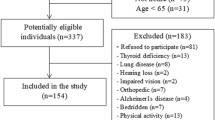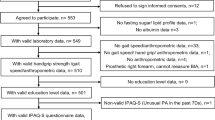Abstract
Background/Objectives:
The objectives of this study were to determine the prevalence of muscle weakness using the two 2014 Foundation for the National Institutes of Health (FNIH) Sarcopenia Project criteria and its relationship with physical limitations, basic activities of daily living (ADL) and instrumental ADL.
Subjects/Methods:
We performed a cross-sectional analysis of community-dwelling adults from the Health and Retirement Study 2006–2008 and identified a subsample of 5092 adults aged ⩾60 years with grip strength (GS) data. Self-reported physical limitations, basic ADL and instrumental ADL were assessed. Criteria for GS (men<26 kg; women <16 kg) and GS adjusted for body mass index (GS/BMI; men <1.0; women <0.56) were applied to the sample. We determined the prevalence of muscle weakness in each sex. Multivariable logistic regression was used to calculate the association of physical limitations, basic ADL and instrument ADL with weakness definitions in each sex.
Results:
Mean age was 72.1 years (54.9% female). Mean GS was 38.3 and 22.9 kg and mean BMI was 29 kg/m2, respectively, in men and women. Weakness prevalence using GS and GS:BMI definitions were 7.8 and 15.2 (P<0.001), respectively, in men and 11.4 and 13.3% (P=0.04) in women. Overall prevalence of physical limitations, basic ADL limitations and instrumental ADL limitations was 52.9, 28.1 and 35.9%, respectively. In those with weakness, prevalence of physical limitations, basic ADL and instrumental ADL was 78.5, 42.3 and 65.3%, respectively, using the GS definition, and 79.7, 40.7 and 58.8%, respectively, using the GS/BMI definition. GS and the GS/BMI definitions of weakness were strongly associated with physical limitations (odds ratio (OR) 2.19 (95% confidence interval (CI): (1.67–2.87)) and 2.52 (2.01–3.17)), basic ADL (OR 1.59 (1.22–2.07) and 1.66 (1.32–2.07)) and instrumental ADLs (OR 1.98 (1.28–2.54) and 1.78 (1.44–2.20)).
Conclusions:
The new FNIH guidelines for weakness are associated with higher prevalence of physical limitations, basic ADL impairments and instrumental ADL impairments as compared with individuals without weakness.
This is a preview of subscription content, access via your institution
Access options
Subscribe to this journal
Receive 12 print issues and online access
$259.00 per year
only $21.58 per issue
Buy this article
- Purchase on Springer Link
- Instant access to full article PDF
Prices may be subject to local taxes which are calculated during checkout


Similar content being viewed by others
References
Sayer AA, Syddall H, Martin H, Patel H, Baylis D, Cooper C . The developmental origins of sarcopenia. J Nutr Health Aging 2008; 12: 427–432.
Roubenoff R, Dallal GE, Wilson PW . Predicting body fatness: the body mass index vs estimation by bioelectrical impedance. Am J Public Health 1995; 85: 726–728.
Newman AB, Kupelian V, Visser M, Simonsick EM, Goodpaster BH, Kritchevsky SB et al. Strength, but not muscle mass, is associated with mortality in the health, aging and body composition study cohort. J Gerontol A Biol Sci Med Sci 2006; 61: 72–77.
Visser M, Kritchevsky SB, Goodpaster BH, Newman AB, Nevitt M, Stamm E et al. Leg muscle mass and composition in relation to lower extremity performance in men and women aged 70 to 79: The health, aging and body composition study. J Am Geriatr Soc 2002; 50: 897–904.
Studenski SA, Peters KW, Alley DE, Cawthon PM, McLean RR, Harris TB et al. The FNIH sarcopenia project: rationale, study description, conference recommendations, and final estimates. J Gerontol A Biol Sci Med Sci 2014; 69: 547–558.
Batsis JA, Barre LK, Mackenzie TA, Pratt SI, Lopez-Jimenez F, Bartels SJ . Variation in the prevalence of sarcopenia and sarcopenic obesity in older adults associated with different research definitions: dual-energy X-ray absorptiometry data from the National Health and Nutrition Examination Survey 1999-2004. J Am Geriatr Soc 2013; 61: 974–980.
Cruz-Jentoft AJ, Baeyens JP, Bauer JM, Boirie Y, Cederholm T, Landi F et al. Sarcopenia: European consensus on definition and diagnosis. Age Ageing 2010; 39: 412–423.
Studenski S, Perera S, Patel K, Rosano C, Faulkner K, Inzitari M et al. Gait speed and survival in older adults. JAMA 2011; 305: 50–58.
Alley DE, Shardell MD, Peters KW, McLean RR, Dam TT, Kenny AM et al. Grip strength cutpoints for the identification of clinically relevant weakness. J Gerontol A Biol Sci Med Sci 2014; 69: 559–566.
Germain CM, Vasquez E, Batsis JA . Physical activity, central adiposity and functional limitations in community dwelling older adults. J Geriatr Phys Ther 2015; 39: 71–76.
Batsis JA, Nieto-Martinez RE, Lopez-Jimenez F . Metabolic syndrome: from global epidemiology to individualized medicine. Clin Pharmacol Ther 2007; 82: 509–524.
Bohannon RW, Peolsson A, Massy-Westropp N, Desrosiers J, Bear-Lehman J . Reference values for adult grip strength measured with a Jamar dynamometer: a descriptive meta-analysis. Physiotherapy 2006; 92: 11–15.
Batsis JA, Mackenzie TA, Barre LK, Lopez-Jimenez F, Bartels SJ . Sarcopenia, sarcopenic obesity and mortality in older adults: results from the National Health and Nutrition Examination Survey III. Eur J Clin Nutr 2014; 68: 1001–1007.
Sallinen J, Stenholm S, Rantanen T, Heliovaara M, Sainio P, Koskinen S . Hand-grip strength cut points to screen older persons at risk for mobility limitation. J Am Geriatr Soc 2010; 58: 1721–1726.
Desrosiers J, Bravo G, Hebert R, Dutil E . Normative data for grip strength of elderly men and women. Am J Occup Ther 1995; 49: 637–644.
Keevil VL, Luben R, Dalzell N, Hayat S, Sayer AA, Wareham NJ et al. Cross-sectional associations between different measures of obesity and muscle strength in men and women in a British cohort study. J Nutr Health Aging 2015; 19: 3–11.
Stenholm S, Sainio P, Rantanen T, Alanen E, Koskinen S . Effect of co-morbidity on the association of high body mass index with walking limitation among men and women aged 55 years and older. Aging Clin Exp Res 2007; 19: 277–283.
Batsis JA, Lopez-Jimenez F . Cardiovascular risk assessment—from individual risk prediction to estimation of global risk and change in risk in the population. BMC Med 2010; 8: 29.
Ogden CL, Carroll MD, Kit BK, Flegal KM . Prevalence of childhood and adult obesity in the United States, 2011-2012. JAMA 2014; 311: 806–814.
Baumgartner RN, Koehler KM, Gallagher D, Romero L, Heymsfield SB, Ross RR et al. Epidemiology of sarcopenia among the elderly in New Mexico. Am J Epidemiol 1998; 147: 755–763.
Rolland Y, Lauwers-Cances V, Cristini C, Abellan van Kan G, Janssen I, Morley JE et al. Difficulties with physical function associated with obesity, sarcopenia, and sarcopenic-obesity in community-dwelling elderly women: the EPIDOS (EPIDemiologie de l'OSteoporose) Study. Am J Clin Nutr 2009; 89: 1895–1900.
Reuben DB . Medical care for the final years of life: "When you're 83, it's not going to be 20 years". JAMA 2009; 302: 2686–2694.
Acknowledgements
This work was funded in part by the Department of Medicine, Geisel School of Medicine at Dartmouth and the Dartmouth Centers for Health and Aging. Support was also provided in part by the Dartmouth Health Promotion and Disease Prevention Research Center supported by Cooperative Agreement Number U48DP005018 from the Centers for Disease Control and Prevention. The findings and conclusions in this journal article are those of the authors and do not necessarily represent the official position of the Centers for Disease Control and Prevention.
Author contributions
JAB—conception, design, acquired data, analysis and interpretation, drafted the article, and final approval of the version to be published. CMG—conception, design, acquired data, analysis and interpretation, revised the article critically for important intellectual content, and final approval of the version to be published. EV—conception, design, acquired data, analysis and interpretation, revised article critically for important intellectual content, and final approval of the version to be published. SJB—analysis and interpretation, revised article critically for important intellectual content, and final approval of the version to be published.
Author information
Authors and Affiliations
Corresponding author
Ethics declarations
Competing interests
JAB receives funding from Health Resources Services Administration (UB4HP19206-01-00) for medical geriatric teaching, the Junior Faculty Career Development Award, the Department of Medicine, Dartmouth–Hitchcock Medical Center, the Dartmouth Centers for Health and Aging, the National Institute of Mental Health (K12 HS0217695 (AHRQ), NIMH: T32 MH073553, R01 MH078052, R01 MH089811; R24 MH102794; CDC U48DP005018). The remaining authors declare no conflict of interest.
Additional information
Work presented at the International Conference on Frailty and Sarcopenia 2015, Boston, MA, USA.
Supplementary Information accompanies this paper on European Journal of Clinical Nutrition website
Rights and permissions
About this article
Cite this article
Batsis, J., Germain, C., Vásquez, E. et al. Prevalence of weakness and its relationship with limitations based on the Foundations for the National Institutes for Health project: data from the Health and Retirement Study. Eur J Clin Nutr 70, 1168–1173 (2016). https://doi.org/10.1038/ejcn.2016.90
Received:
Revised:
Accepted:
Published:
Issue Date:
DOI: https://doi.org/10.1038/ejcn.2016.90
This article is cited by
-
Muscle mass rather than muscle strength or physical performance is associated with metabolic syndrome in community-dwelling older Chinese adults
BMC Geriatrics (2021)
-
Prevalence of motor impairment in residents of New South Wales, Australia aged 55 years and over: cross-sectional survey of the 45 and Up cohort
BMC Public Health (2020)
-
Muscle Weakness and Physical Disability in Older Americans: Longitudinal Findings from the U.S. Health and Retirement Study
The Journal of nutrition, health and aging (2018)
-
Prevalence of clinically relevant muscle weakness and its association with vitamin D status among older adults in Ecuador
Aging Clinical and Experimental Research (2017)



